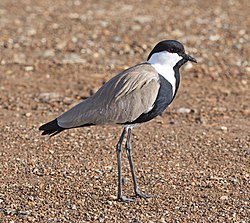This article needs additional citations for verification .(February 2024) |
| Spur-winged lapwing | |
|---|---|
 | |
| Upper side of wings - note the spurs on the leading edge of the carpal joint | |
| Calls recorded at Lake Turkana, Kenya | |
| Scientific classification | |
| Kingdom: | Animalia |
| Phylum: | Chordata |
| Class: | Aves |
| Order: | Charadriiformes |
| Family: | Charadriidae |
| Genus: | Vanellus |
| Species: | V. spinosus |
| Binomial name | |
| Vanellus spinosus | |
| Synonyms | |
Charadrius spinosus Linnaeus, 1758 Contents | |
The spur-winged lapwing or spur-winged plover (Vanellus spinosus) is a lapwing species, one of a group of largish waders in the family Charadriidae.








